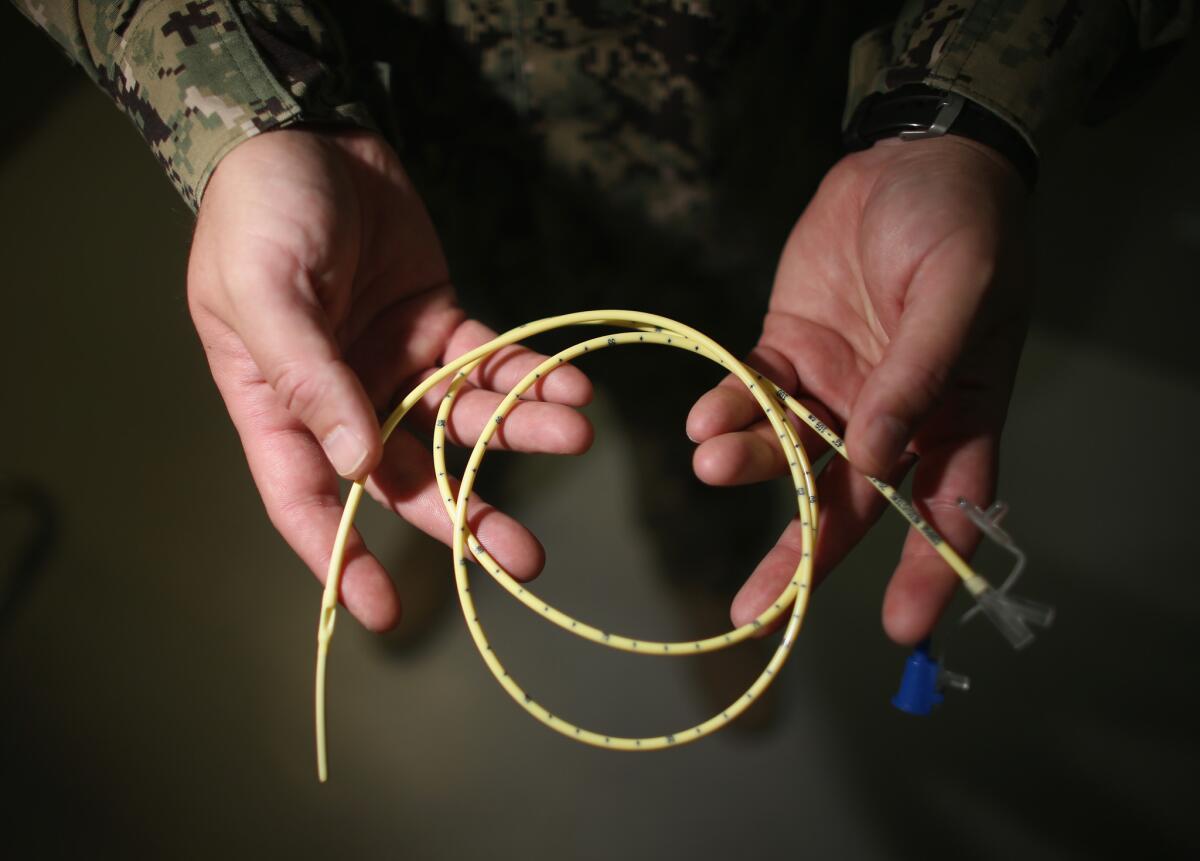A force-feeding disgrace at Guantanamo

- Share via
Prominent senators, the American Medical Assn., human rights activists and a federal judge agree: The force-feeding of more than 40 hunger strikers at the prison at Guantanamo Bay is a disgrace. What’s more, it also appears to be a violation of prohibitions in international law against cruel, inhumane and degrading treatment.
The process itself is disgusting: Food is forced through a 2-foot-long nasal tube down the throat and into the stomach while the prisoner is immobilized. It requires an enormous commitment of medical personnel: 140 Navy doctors, nurses and corpsmen, including 37 reinforcements dispatched in April to accommodate the spreading hunger strike. Like Guantanamo itself, the force-feeding of the strikers has fueled anti-American opinion abroad. (And that’s unlikely to be undone by the Pentagon’s surreal decision to confine force-feeding to nighttime so that inmates won’t be violating the Ramadan fast.)
The Pentagon wouldn’t be facing this agonizing problem if President Obama had made good on his promise in his first term to close Guantanamo and move its inmates (now numbering 166) either to foreign countries or to a secure prison in the United States. But thanks to both congressional opposition and his skittishness about returning prisoners to countries that serve as breeding grounds for terrorism, 86 prisoners cleared for release in 2010 remain at the prison. Of the remaining 80 inmates, 46 have been classified by an administrative task force as too dangerous to release and impossible to put on trial, and the rest are undergoing or awaiting trial by military commissions.
Although the hunger strike was initiated as a protest against intrusive searches of personal belongings, it now involves more than 100 prisoners and has become a primal scream against indefinite detention.
After treating the issue of Guantanamo with malign neglect for much of his first term, Obama recently refocused on closing the facility, which he rightly calls a recruitment tool for extremists. The president lifted a blanket moratorium on repatriations to Yemen — allowing for case-by-case determinations — and has appointed a prominent lawyer, Clifford Sloan, to help expedite the transfer of inmates to other countries. He also has called on Congress to lift legal restrictions on transferring detainees to foreign countries or to prisons in the U.S. The question is whether he has the resolve to veto a version of the next Defense Authorization Act if it continues to impose those restrictions.
Finally, Obama has pledged, rather vaguely, that the problem of inmates who can’t be put on trial “can be resolved, consistent with our commitment to the rule of law.” We hope that means he is having second thoughts about denying those inmates a meaningful day in court. It isn’t enough that the physical Guantanamo be closed down; due process needs to be afforded to inmates even if they are moved to the United States.
Progress on moving inmates out of their legal limbo over the next few months will dispose of the principal justification for the hunger strike. But what should officials do in the meantime with the prisoners who are starving themselves to death?
It isn’t just the military that resorts to force-feeding when a prisoner refuses food and drink. So do civilian prisons in the U.S. There are two principal justifications: the need to maintain order and discipline, and a humanitarian emphasis on preserving human life. Defenders of force-feeding compare it to the suicide watches that prisons maintain when an inmate is considered psychologically vulnerable. A prisoner who takes his own life, whether by hanging himself or refusing food, deprives his future self of the ability to change his mind.
Critics of force-feeding make several arguments. Some focus on the pain inflicted on a prisoner when a tube is forced through his nose, a procedure they have compared to waterboarding. In a letter to Obama in which they called for an end to “large-scale force-feedings,” Sens. Dianne Feinstein (D-Calif.) and Richard J. Durbin (D-Ill.) urged the Pentagon to adopt protections in place at federal prisons. Though the senators weren’t specific, U.S. Bureau of Prisons guidelines say that where nasogastric feeding is unsuccessful or medically inappropriate, doctors can order intravenous delivery of fluids.
But even if involuntary feeding could be made less painful, forcing a prisoner to eat is still a violation of his autonomy and personal choice. In a 1990 case, the Supreme Court said it assumed that the Constitution “would grant a competent person a constitutionally protected right to refuse lifesaving hydration and nutrition.” It also can be argued that a mentally competent prisoner who wants to starve himself to make a political point or to protest conditions is engaging in free speech.
Last week, U.S. District Judge Gladys Kessler ruled that she lacked jurisdiction to end the force-feeding of Jihad Dhiab, who has been held at Guantanamo for 11 years despite having been cleared for release in 2010. But she wrote that “there is an individual who does have the authority to address the issue” — the president. She quoted a speech in May in which Obama said: “Look at the current situation, where we are force-feeding detainees who are holding a hunger strike.... Is that who we are? Is that something that our founders foresaw? Is that the America we want to leave to our children? Our sense of justice is stronger than that.”
Obama should be true to his own words and stop the force-feeding at Guantanamo, even as he belatedly strives to remedy the conditions that caused the hunger strike in the first place.
More to Read
A cure for the common opinion
Get thought-provoking perspectives with our weekly newsletter.
You may occasionally receive promotional content from the Los Angeles Times.









